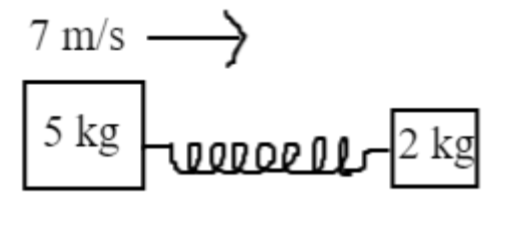
Two blocks of masses 5kg and 2kg are connected by a spring of negligible mass and placed on a frictionless horizontal surface. An impulse provides a velocity of $7m/s$ to the heavier block in the direction of the lighter block. The velocity of the center of mass is
\[
A.{\text{ }}4m/s \\
B.{\text{ }}5m/s \\
C.{\text{ }}10m/s \\
D.{\text{ }}3m/s \\
\]
Answer
574.8k+ views
Hint: In order to solve this problem we will use the formula for the velocity of the center of mass of two masses with the help of the values provided in the problem. We will use the velocity of the second mass as zero as no impulse is provided to the second block.
Formula used- ${V_{cm}} = \dfrac{{{m_1}{v_1} + {m_2}{v_2}}}{{{m_1} + {m_2}}}$
Complete step-by-step solution:

Given that two blocks of masses 5kg and 2kg.
Let ${m_1} = 5kg$
And ${m_2} = 2kg$
Given that impulse is provided to first block
So, ${v_1} = 7m/s$
Here light block of 2kg is at rest so the velocity of second block will be zero
So ${v_2} = 0m/s$
We know that velocity of the centre of mass is given as
${V_{cm}} = \dfrac{{{m_1}{v_1} + {m_2}{v_2}}}{{{m_1} + {m_2}}}$
Substitute all the given values in above formula, we get
\[
\because {V_{cm}} = \dfrac{{{m_1}{v_1} + {m_2}{v_2}}}{{{m_1} + {m_2}}} \\
\Rightarrow {V_{cm}} = \dfrac{{5 \times 7 + 2 \times 0}}{{5 + 2}} \\
\Rightarrow {V_{cm}} = \dfrac{{35}}{7} \\
\Rightarrow {V_{cm}} = 5m/s \\
\]
Hence, the velocity of the centre of mass is \[5m/s\]
So, the correct answer is option B.
Note: The center of mass of a mass distribution in space is the particular point where the relative weighted position of the distributed mass sums is at zero. This is the point at which a force can be applied without an angular acceleration to cause linear acceleration. The center of mass is a useful reference point for calculations in mechanics involving spatially distributed masses, such as the planetary bodies' linear and angular momentum and rigid body dynamics.
Formula used- ${V_{cm}} = \dfrac{{{m_1}{v_1} + {m_2}{v_2}}}{{{m_1} + {m_2}}}$
Complete step-by-step solution:

Given that two blocks of masses 5kg and 2kg.
Let ${m_1} = 5kg$
And ${m_2} = 2kg$
Given that impulse is provided to first block
So, ${v_1} = 7m/s$
Here light block of 2kg is at rest so the velocity of second block will be zero
So ${v_2} = 0m/s$
We know that velocity of the centre of mass is given as
${V_{cm}} = \dfrac{{{m_1}{v_1} + {m_2}{v_2}}}{{{m_1} + {m_2}}}$
Substitute all the given values in above formula, we get
\[
\because {V_{cm}} = \dfrac{{{m_1}{v_1} + {m_2}{v_2}}}{{{m_1} + {m_2}}} \\
\Rightarrow {V_{cm}} = \dfrac{{5 \times 7 + 2 \times 0}}{{5 + 2}} \\
\Rightarrow {V_{cm}} = \dfrac{{35}}{7} \\
\Rightarrow {V_{cm}} = 5m/s \\
\]
Hence, the velocity of the centre of mass is \[5m/s\]
So, the correct answer is option B.
Note: The center of mass of a mass distribution in space is the particular point where the relative weighted position of the distributed mass sums is at zero. This is the point at which a force can be applied without an angular acceleration to cause linear acceleration. The center of mass is a useful reference point for calculations in mechanics involving spatially distributed masses, such as the planetary bodies' linear and angular momentum and rigid body dynamics.
Recently Updated Pages
Why are manures considered better than fertilizers class 11 biology CBSE

Find the coordinates of the midpoint of the line segment class 11 maths CBSE

Distinguish between static friction limiting friction class 11 physics CBSE

The Chairman of the constituent Assembly was A Jawaharlal class 11 social science CBSE

The first National Commission on Labour NCL submitted class 11 social science CBSE

Number of all subshell of n + l 7 is A 4 B 5 C 6 D class 11 chemistry CBSE

Trending doubts
What is meant by exothermic and endothermic reactions class 11 chemistry CBSE

10 examples of friction in our daily life

One Metric ton is equal to kg A 10000 B 1000 C 100 class 11 physics CBSE

1 Quintal is equal to a 110 kg b 10 kg c 100kg d 1000 class 11 physics CBSE

Difference Between Prokaryotic Cells and Eukaryotic Cells

What are Quantum numbers Explain the quantum number class 11 chemistry CBSE




